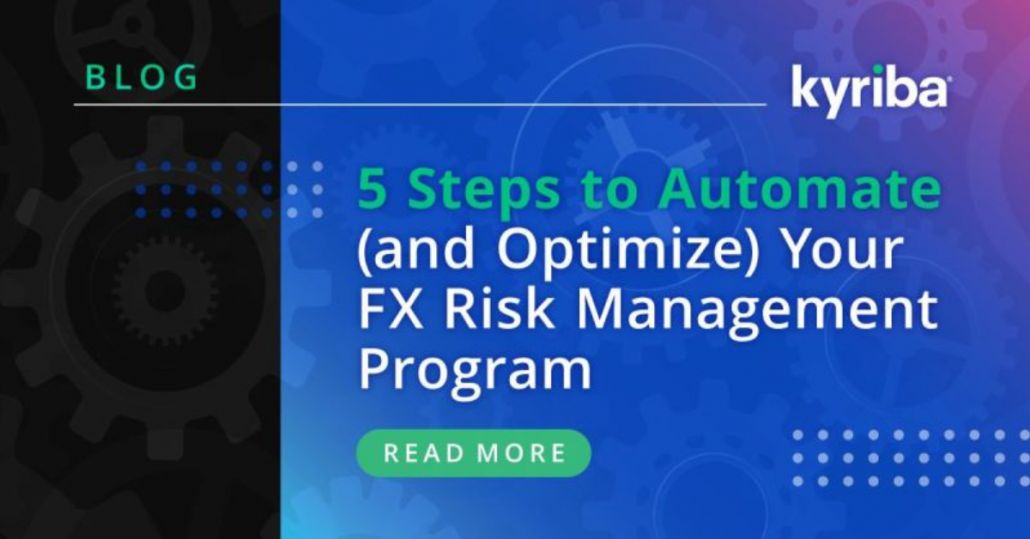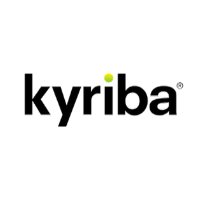5 Steps to Automate (and Optimize) Your FX Risk Management Program
03-10-2022 | treasuryXL | Kyriba | LinkedIn |
Companies of all sizes and industries with FX exposures are being impacted by global trade complexities. New dynamics are putting CFOs and treasurers’ FX strategies and their ability to explain results to the test. Automating an FX management program provides numerous advantages. Diminishing the need for manual involvement frees corporate risk, treasury, finance, and accounting teams from sourcing information manually from multiple systems, compiling and uploading it into spreadsheets and finally attempting to put all of this into a management report that is timely.
By Brian Blihovde
Senior Director, Product Marketing

Companies of all sizes and industries with foreign currency exposures are being impacted by a number of global trade complexities. For many, supply chain disruptions, interest rate, and price index increases are taking a toll on profitability. For many others, the impact from increased foreign currency headwinds is becoming the glaring reality unveiling weaknesses in FX risk management programs. CFOs are having a more challenging time predicting income statement impacts in both directions: favorable and adverse; neither direction is good, particularly for publicly traded enterprises. New dynamics are putting CFOs and treasurers’ FX strategies and the ability to explain results, to the test. Using leading practices supported by leading solutions helps CFOs and finance leaders overcome these challenges of reliance upon manual, spreadsheet-based workflows.
Whether your organization is starting, advancing, or reassessing your individual FX risk programs, there are levels of benefits, value and success metrics tied to how exposed and how uncertain your levels of fx risk management are. For instance, are you able to identify exposures, aggregate and categorize them? Are those balances generated from automated journal entries or is there a manual component? Across your systems, how well are market exchange rates used and applied across the ERP, GL, procurement, billing, or FP&A modules? How often? Finally, and probably one of the most overlooked attributes, how long does it take and the number of staff who participate in attempting to gain access to even a partial picture of your FX risk? How efficient is the draw of FX data? Ultimately much effort is put into converting that data into information and what do the lags in the timeliness of the information you, as CFO are using to make decisions? The answer lies in a company’s ability to invest in technology and process transformation that can stem from that investment.
Automating the FX Management Process
Diminishing the need for manual involvement or onerous workarounds, frees corporate risk, treasury, finance and accounting teams from sourcing information manually from multiple systems, compiling and uploading into spreadsheets and finally attempting to put all of this into a management report that is timely. The giving them more time to analyze information, track exposure trends and proactively seek out other opportunities to eliminate risk. Ultimately, automation transforms how treasury professionals are perceived within an organization, allowing them to be seen as a key resource in strategic planning. The implementation of an FX management program provides numerous advantages, but the three high-level areas for the entire finance organization and business divisions exist:
- A complete picture – Gain a clear understanding of how currency is impacting the entire organization and create reports to analyze exposures in real time
- Maximum control of the business – Gain confidence in data quality and exposure accuracy to be able to detect underlying details that are not obvious in manual spreadsheet environments
- Informed business decisions – Incorporate historical business cycles, trends and the business insights gained from having detailed data to make better hedging decisions and drive better FX management results
- Growth and Scalability / Integrating M&A – business expansion, in the form of acquiring new business units and attempting to run consolidations on them is hard enough. Automation through leading technology can help take advantage of acquisitions and eliminate delays in synchronization from outlier processes or legacy mismatches in risk policy
FX Risk Management Automation: Implications for your Organization
The use of technology does not merely indicate that the application of technology will result in system integration and process automation. Yes, this is one of the starting blocks of taking good processes and creating time-saving opportunities to generate better decision-making with cost-savings optimization. One focus of FX Hedge Management optimization will involve operational cost savings, but another focus should be on taking more of a role in assessing overall strategic success of your hedging through currency pair correlated VaR analyses and scenario analyses. Having more analytical power from technology automation can speed access to better information on your overall cost of hedging foreign currency risk.
Evaluating your FX Risk Program Operations
When evaluating your FX management programs, organizations should consider which of the following aspects of their FX workflow requires better efficiency and effectiveness:
- Data collection automation can eliminate manual time spent on the collection of exposure data and enable teams make better decisions based on the most accurate information
- Calculation and analysis of exposures automatically determines the impacts of rate changes, identify impacts that surpass materiality thresholds, and pinpoint accounting or posting issues
- Hedging and trade preparation processes are pre-proposed from exposure information to ensure corporate decision strategy or policy application and trades are automatically prepared for submission following hedge approval
- Compliance automation enables the standardization of compliance practices and ensures that documentation contains historical audit trails for reporting purposes
- End-to-end workflow automation eliminates manual processes and human error for an improvement in both efficiency and security
Expanding Analytical Capabilities
Technology solutions should undergo assessment for various capabilities that are part of leading analytical aspects of the FX Risk program. For instance, portfolio VaR analyses can help companies create portfolio views or dive into targeted gross/net exposures while considering the cost of a hedge across specific currency pairs, portfolios. Automation for running simulations helps determine top hedging scenarios that your risk managers can analyze to determine what currency pairs to hedge and what the resulting net exposure and portfolio value at risk will be. Access to automated dashboards and FX business intelligence gives your treasury and finance leaders the ability to Identify strategies to reduce costs and improve the efficiency of your exposure management and hedging programs across specific parameters and filters. If you cannot choose various exposures, legal entity slices, or currency selections, you are not optimally running an automated or efficient FX program. Finally, FX trade desk workflow automation and confirmation capabilities for the back-office is often under-estimated as entering and executing FX trades is part of operational or physical workflows attributed to the program. However, the implications to generating entries, integration to trading or confirmation platforms makes this an integral part of FX Risk processes.
5 Steps to Create an FX Automation Roadmap
The goal is the create a plan and roadmap to optimize and transform the way your finance organization collects, analyzes, aggregates, and mitigates risk from foreign currency exposures. One suggested approach is to work with FX Advisors to help you understand where you are and how to get there. As always, having a plan, success measures tied back to value drivers helps programs succeed.
| FX Improvement Steps | Objectives, Guidance | |
1. |
Identify Systems, Sources of Exposures |
Often, there are a wide array and extensive network of foreign currency denominated transactions; and extremely unlikely to be creating offsets that could qualify as natural hedges. The inventory of systems in an extensive matrix is a very good starting point. |
2. |
Assess Integrity of your FX data, GL accounts, & source postings |
Once the system landscape is understood, how well are the controls on your ERPs, ancillary systems and manual transactions coming from sub-ledgers? Are your financial statements subject to shifts from erroneous transactional impacts? |
3. |
Select and deploy technology targeting automation |
Consolidating technology platforms into one risk management platform, allows finance organizations to save significant, material cost amounts and increase profitability from merely being accurate in their hedging activities. Fully automating your FX management program with technology, which entails modernizing data collection, exposure consolidation, calculation and analysis, and hedging recommendations, ensures an organization is operating in step with current FX best practices. |
4. |
Target a full, end to end solution |
Your technology solution should provide for:
|
5. |
Customizable, Flexible Business Intelligence |
Reporting and dashboards create relevant and valued analytics at your fingertips with real-time speed and automation. |
Kyriba’s FX Advisory Services professionals give you leading practice advice and guidance in identifying, assessing, measuring, and implementing positive FX Risk Management results across your people, processes and systems. Learn how to improve and transform your FX Risk Management profile into more predictable and effective hedging results
Learn more about Kyriba’s leading FX Risk Management solution and our FX Advisory Team today. Reach out to our team of FX Risk Management professionals at: [email protected]












